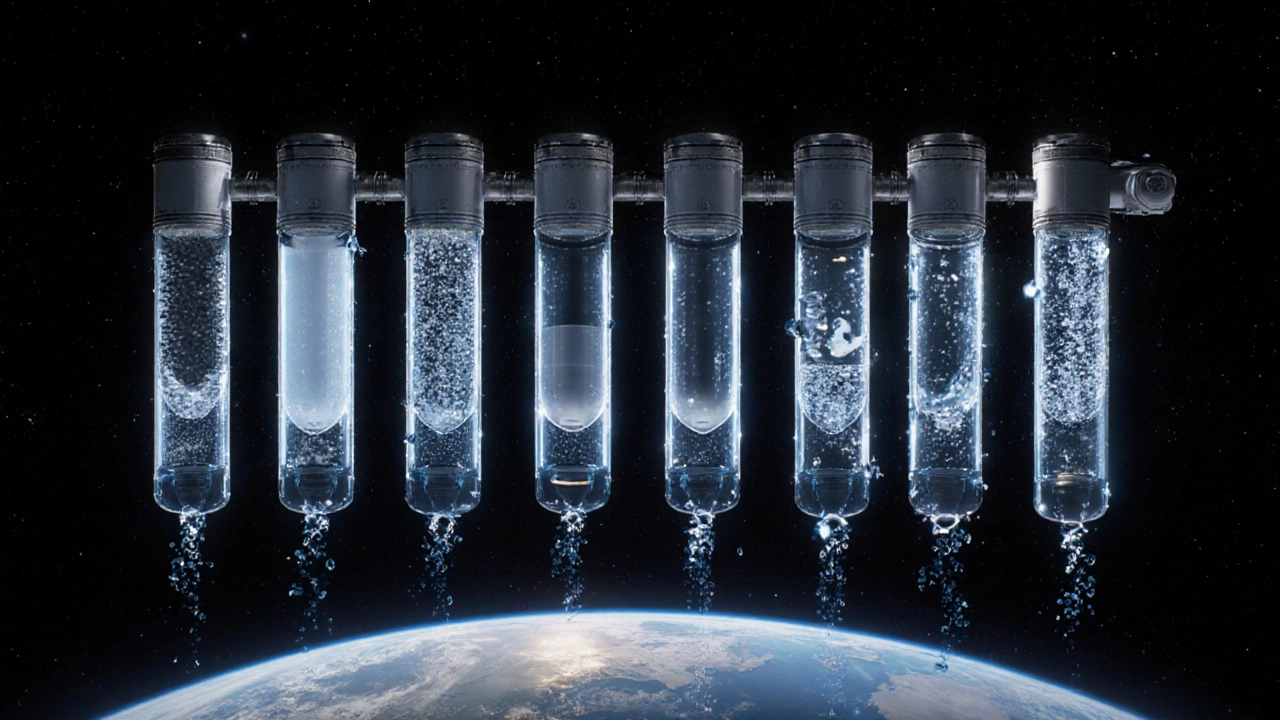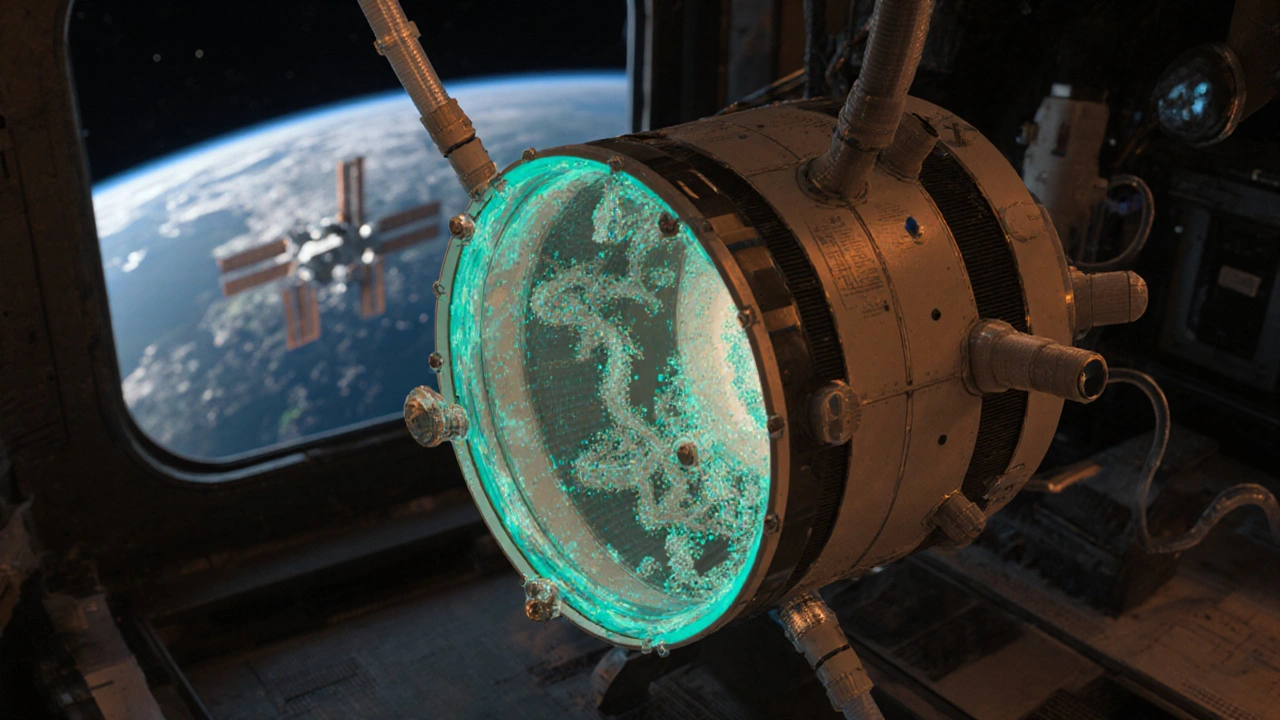On the International Space Station, astronauts don’t just drink water-they drink urine. Not the kind you’re thinking of. They drink water that was once sweat, breath, and urine, cleaned so thoroughly it’s safer than most tap water on Earth. This isn’t science fiction. It’s the reality of living in space for months or years. And it’s the only way humans can survive long missions to the Moon, Mars, or beyond.
Why Water Recycling Isn’t Optional in Space
Sending water to space costs about $22,000 per liter. That’s not a typo. For a six-person crew on a 180-day mission, you’d need over 3,000 liters of water just for drinking, hygiene, and food prep. That’s more than $66 million in transport costs alone. And that’s before you even think about a Mars mission, which could last three years. Resupply missions aren’t feasible. You can’t wait months for a cargo ship to arrive if your water runs out. That’s why NASA built a system that turns waste into water. Not just a little. Not 70%. Not 80%. 98%. That’s the target. And on the ISS, they’ve hit it.How the ISS Water Recovery System Works
The Water Recovery System (WRS) on the ISS isn’t one machine. It’s two main systems working together: the Urine Processor Assembly (UPA) and the Water Processor Assembly (WPA). Together, they handle everything from sweat on the walls to bathroom flushes. The UPA starts the process. It spins urine at 30,000 revolutions per minute in a vacuum, heating it to 80-90°C. This boils off the water while leaving behind salts and urea. It pulls out about 75% of the water from urine. The rest becomes a thick, salty brine-until 2022, when NASA added the Brine Processor Assembly (BPA). That new unit pulls another 10-15% of water from that leftover sludge using warm, dry air and special membranes. Now, nearly every drop counts. That water, along with sweat and humidity from the air, moves to the WPA. Here, it goes through six stages:- Two filters remove particles down to 1 micron-smaller than a bacterium.
- Activated carbon and ion-exchange resins soak up chemicals and odors.
- A catalytic reactor heats the water to 130°C with oxygen, breaking down organic waste into harmless bits.
- More ion-exchange polishing removes leftover ions.
- Iodine is added to kill any lingering microbes.
- Final sensors check conductivity and organic content to make sure it’s clean.
What Makes This System So Different from Earth
On Earth, water treatment plants use bacteria, gravity, and large tanks. Space doesn’t have any of that. No gravity means liquids don’t settle. No room means every liter of equipment has to be compact. And the waste? It’s worse than sewage. Astronaut urine has 2-3 times more urea than human waste on Earth. Salt levels are higher. And there’s no sewer system to flush it away. The system has to handle all of this in a sealed, pressurized box floating in zero-g. Even the way it’s maintained is different. Crew members train for 40 hours before touching a single valve. They learn fluid dynamics, chemical reactions, and how to fix a broken sensor in a spacesuit. Every month, they swap out filters. Every quarter, they check the catalytic reactor. Every year, they do a full system overhaul. Ground teams in Houston watch every reading in real time.
What’s Next: The Next-Gen Water Systems
The current system works-but it’s not perfect. It needs new filters, chemicals, and parts every year. About 120 kilograms of replacement gear. That’s a lot of weight to launch into space. For a Mars mission, you can’t afford to bring that much. NASA is working on three big upgrades:- Biological Water Processor: Instead of filters and chemicals, this system uses microbes to eat waste. It’s like a mini sewage plant, but in a jar. Early tests show it could cut consumables by half. Testing on the ISS is planned for 2026.
- Supercritical Water Oxidation (SCWO): This tech uses extreme heat and pressure-374°C and over 200 times Earth’s atmospheric pressure-to turn organic waste into pure water and CO2. Ground tests show it destroys 99.9% of contaminants. The prototype, called SCWO-FPV, will fly to the ISS in 2027.
- Advanced Brine Dewatering System: This one aims for 99.5% recovery by improving the membranes used to pull water from brine. It’s already being tested in labs in Texas and California.
Reliability: The Biggest Fear
Astronauts trust the system. Shane Kimbrough, commander of Expedition 65, said, “The water tastes great and we trust it completely.” An anonymous astronaut in a 2022 survey said, “Knowing our water is safe and abundant lets us focus on science rather than survival.” But engineers worry. The system has been running since 2008. It’s been reliable-but it’s never had to run for 15 years straight without a single major failure. That’s what a Mars mission needs. There have been two big breakdowns: one in 2010, when the catalytic reactor failed and recovery dropped 15% for 17 days. Another in 2019, when the brine separator jammed and took three weeks to fix. Most issues are small-clogged filters or sensor drift-and get fixed within two days. But in deep space, a small glitch can become a disaster. NASA’s 2023 risk report lists water system failure as the third biggest threat to a Mars mission-right after radiation and propulsion.


12 Responses
This is wild. I mean, we’re talking about drinking pee here, but it’s actually cleaner than my tap water back in Delhi. The tech is insane. NASA didn’t just build a filter-they built a miracle in a box.
And the fact that they’re pulling 98% recovery? That’s not engineering. That’s alchemy.
The precision of this system is extraordinary. Every component, from the catalytic reactor to the ion-exchange resins, has been meticulously designed to function in an environment devoid of gravity, where even the simplest fluid dynamics behave unpredictably. It is a testament to human ingenuity that such a closed-loop system not only operates but thrives under these constraints.
I just can’t imagine drinking my own sweat water. It’s too much for me.
Okay so let me get this straight-we turn pee into water, and then we drink it, and it tastes BETTER than Earth water??
Bro. I’m not even mad. I’m impressed. Like… this is the most sci-fi thing I’ve ever heard that’s REAL. Like, if this doesn’t get a Netflix docu-series, the universe is broken.
Also-what if the filter breaks mid-mission? I’m sweating just thinking about it. 😅
98% recovery? Pfft. That’s still 2% waste. You call that efficient? I’ve seen my cousin’s rooftop rainwater tank in Jaipur that recovers 99.5% and it’s held together with duct tape and hope. NASA’s got fancy machines but they’re still playing with training wheels.
And don’t even get me started on iodine as a disinfectant. That’s like using a toothbrush to clean a sewer. The real solution? Bioreactors. Duh. Everyone else is just slow.
Water is the original ghost. It remembers everything it touches-sweat, breath, fear, laughter. And yet, in the silence of space, it returns to its purest form, not by magic, but by the relentless will of human hands.
Is it not profound that the most intimate waste of our bodies becomes the sacred vessel of survival? We are not just astronauts-we are alchemists of the soul, transmuting decay into life.
And still, we fear the moment the machine falters. Because in the void, even water has a heartbeat-and we are terrified it will stop.
This is one of the most underappreciated achievements in modern engineering. The fact that we can sustain human life in space using only what we bring-and recycle nearly everything-is a milestone that deserves far more public recognition.
It’s not just about Mars. It’s about rethinking how we use resources on Earth. If we can do this in orbit, why aren’t we doing more of this here?
98%? More like 85% if you ask me. They’re lying to make NASA look good. And that ‘tastes better’ thing? Total PR spin. No way that’s true. Also, why are they still using iodine? That’s 1970s tech. And the brine processor? Bro, that thing jams every 3 months. I’ve read the logs. It’s a nightmare. And don’t even get me started on the ‘catalytic reactor’-half the time it’s just overheating and the crew has to manually reboot it. They’re barely holding it together.
Wait so… you’re telling me astronauts drink their own pee? Like… literally? And they’re cool with that? I mean, I get the science, but… I just… can’t. I’d be like, ‘nope, I’m drinking the last bottle of space water I brought from Earth.’
Also, how do you even explain that to your kids? ‘Yeah sweetie, Mommy drank yesterday’s sweat today.’
It’s fascinating how such a simple necessity-water-becomes the ultimate test of human resilience. No grand explosions, no dramatic launches. Just quiet machines humming, turning the unwanted into the essential.
Maybe that’s the real lesson: survival isn’t about being loud. It’s about being precise.
Oh please. ‘Tastes better than Earth water’? That’s what they say when they’ve been drinking recycled urine for 6 months and their taste buds are dead. And ‘98% recovery’? Sure, until the sensor glitches and the whole system floods the module with brine. You think NASA doesn’t have a backup plan? They do. It’s called ‘pray and hope’.
And don’t even get me started on ‘biological processors’-you’re going to put bacteria in a space station? Are you trying to give everyone toxic pneumonia? I’ve seen what happens when you let microbes loose in zero-G. It’s not a lab. It’s a petri dish with a view.
Great breakdown of the system. One thing I’d add: the real unsung hero here is the crew training. 40 hours just to touch a valve? That’s not overkill-it’s survival. Most people don’t realize how much of this is about procedure, discipline, and redundancy.
Also, the fact that they’re testing SCWO and biological processors? That’s the future. Those systems could cut resupply needs by 80% on Mars missions. And the membrane tech? Already being used in Rajasthan to purify groundwater. This isn’t just space tech-it’s Earth tech that just happened to be born in orbit.
Keep pushing. The world needs this.